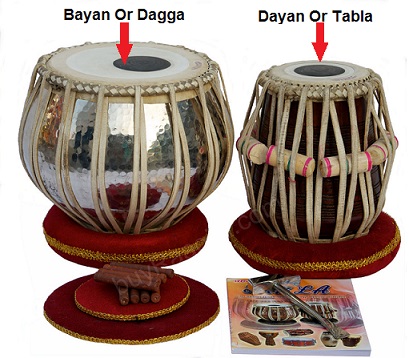What is Tabla
Tabla is the most famous rhythm instrument in Indian Subcontinent, including India, Nepal, Pakistan, Afghanistan, Bangladesh and Sri Lanka. It has two drums, the Bayan or Dagga (big bass drum) and the Dayan, which are collectively called as Tabla.Know more about Various Parts of Tabla here. They are nearly played as one. The Tabla is played with the right hand and the Dagga (or Bayan) by the left hand. In Tabla music, the Bayan is responsible for the bass part, which is played by the first and the middle finger of the left hand in turns or at the same time. But the thumb is put on the edge of the skin. Dayans are played with parallel high or low tuned instruments.

While playing the Tabla instrument, at the bottom of both the drums there are rings that are called as Bira.
Sides of this Indian drum have the tuning wedges (used for tuning the Tabla) that are carried by leather belts (Wadi). If they are beaten upwards or downwards with the help of the tuning hammer, the sound gets lower or higher respectively.
Base of this Tabla drums are closed and the top is covered with generally a goat skin. Its seasoning is done by some special substances. Commonly, covering of the Tabla drums pair are two same-thickness sheets of hardened goat skins. The rim of the skin is attached with a subsequent skin called as Kani. Its centre has ‘GAB’(syahi), which is nothing but a black area. It is the one that makes the Tabla Music extraordinary. However, application of the GAB (syahi) is a skilled job, as it demands the exact combination, stability and potency of rice flour + iron filings paste.
Leather on the surface has the outmost layer as ‘chati’, whereon also the player produces sound. The area that is followed is ‘maidan’. The ink-smeared area and ‘maidan’ are used by the player to generate sound.
The playing method involves a separate use of fingers. The blend of the two Tabla drums produces such a full rhythm that hardly any other rhythm instrument can match with it.
- 87 views
